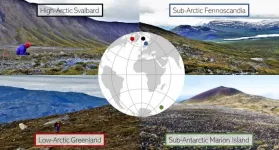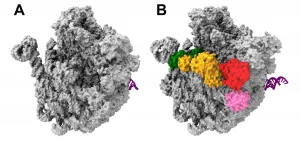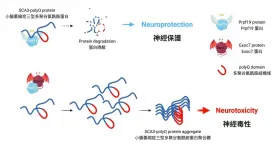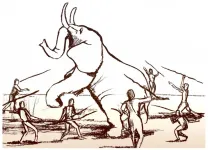Tundra vegetation shows similar patterns along microclimates from Arctic to sub-Antarctic
2021-03-01
(Press-News.org) Researchers are in the search for generalisable rules and patterns in nature. Biogeographer Julia Kemppinen together with her colleagues tested if plant functional traits show similar patterns along microclimatic gradients across far-apart regions from the high-Arctic Svalbard to the sub-Antarctic Marion Island. Kemppinen and her colleagues found surprisingly identical patterns.
It is widely known that global vegetation patterns and plant properties follow major differences in climate. Yet, it has remained a mystery how well the same rules can be applied at very local scales. Are responses to the environment similar in plant communities along local temperature gradients in Svalbard, Greenland, Fennoscandia, and Marion island? The results published in Nature Ecology & Evolution indicate that these generalisable patterns do exist.
The researchers collected field data on 217 species from nearly 7000 study plots. The results revealed strong, consistent plant functional trait-environment relationships across the four tundra ecosystems.
"This is important because plant functional traits inform us how plants use resources, such as soil moisture, and how plants shape their environments such as carbon cycling. In addition, traits investigations can also give a hint on how plants may react to the ongoing climate change", says Post doctoral researcher Julia Kemppinen from the University of Oulu.
The researchers found patterns that hold despite unique species pools and other site-specific characteristics. This information improves the biological basis for climate change impact predictions for vulnerable tundra ecosystems.
At coarse spatial scales, there are clear global climatic patterns in temperature and precipitation. For instance, the high-Arctic Svalbard is generally much colder than sub-Arctic Fennoscandia. However, ground-dwelling plants experience local climate conditions, the microclimate, which plays an important role in how ecosystems are responding to climate change.
"It is fascinating to find very distinct differences in soil moisture and soil temperatures at a local scale. If you look close enough, the warmest micro spots in Svalbard have higher temperatures than the coldest spots in Fennoscandia. These local hydrological and thermal conditions clearly affect plants and their functional traits", says Post doctoral researcher Pekka Niittynen from the University of Helsinki.
The results indicate that the tundra plant communities respond similarly to microclimate. This helps generalising scientific results from one tundra region to another without making too bold conclusions.
Investigating the connections between plant functional traits and the environment requires a lot of data. The researchers combined their field data with over 76000 database trait records provided by the Botanical Information and Ecological Network, TRY Plant Trait Database and the Tundra Trait Team.
"Our research groups at the BioGeoClimate Modelling Lab at the University of Helsinki and the le Roux lab at the University of Pretoria collected a lot of data in the field, but we couldn't have done this study without high-quality, open data from global databases", says professor Miska Luoto from the University of Helsinki.
The study is a part of Kemppinen's PhD thesis Soil moisture and its importance for tundra plants at the University of Helsinki, Helsinki, Finland.
INFORMATION:
The study and data are openly available
Julia Kemppinen, Pekka Niittynen, Peter C. le Roux, Mia Momberg, Konsta Happonen, Juha Aalto, Helena Rautakoski, Brian J. Enquist, Vigdis Vandvik, Aud H. Halbritter, Brian Maitner & Miska Luoto (2021). Consistent trait-environment relationships within and across tundra plant communities. Nature Ecology & Evolution. https://dx.doi.org/10.1038/s41559-021-01396-1
Julia Kemppinen, Pekka Niittynen, Peter C. le Roux, Mia Momberg, Konsta Happonen, Juha Aalto, Helena Rautakoski, Brian J. Enquist, Vigdis Vandvik, Aud H. Halbritter, Brian Maitner & Miska Luoto (2021). Data from: Consistent trait-environment relationships within and across tundra plant communities. Zenodo. https://doi.org/10.5281/zenodo.4362216
Contact information
Post doctoral researcher Julia Kemppinen
Email: julia.kemppinen@oulu.fi
Twitter: @juliakemppinen
Post doctoral researcher Pekka Niittynen
Email: pekka.niittynen@helsinki.fi
Twitter: @PONiittynen
Professor Miska Luoto
Email: miska.luoto@helsinki.fi
[Attachments] See images for this press release:

ELSE PRESS RELEASES FROM THIS DATE:
2021-03-01
Ribosome formation is viewed as a promising potential target for new antibacterial agents. Researchers from Charité - Universitätsmedizin Berlin have gained new insights into this multifaceted process. The formation of ribosomal components involves multiple helper proteins which, much like instruments in an orchestra, interact in a coordinated way. One of these helper proteins - protein ObgE - acts as the conductor, guiding the entire process. The research, which produced the first-ever image-based reconstruction of this process, has been published in Molecular Cell*.
Ribosomes are an essential component of all living cells. Frequently referred to as 'molecular protein factories', they translate genetic information into chains of linked-up ...
2021-03-01
What can you see on this picture (next to thearticle)? Say what comes to your mind immediately!
If you said „star", you focus rather on the details, if you said „sun", then rather on the global pattern.
People can be different in whether they typically see the forest or the trees, but the dominant attentional mode is focusing first on the whole, and then on the details. This is the same with children. Or so it has been until now! Children of the Alpha Generation (who has been born after 2010) typically grow up with mobile devices in their hands which seems to change how they perceive the world, as Hungarian researchers showed.
The Alpha Generation Lab of Diagnostics and Therapy Excellence Programme at Eötvös Loránd University (Budapest) studies ...
2021-03-01
Materials - Quantum building blocks
Oak Ridge National Laboratory scientists demonstrated that an electron microscope can be used to selectively remove carbon atoms from graphene's atomically thin lattice and stitch transition-metal dopant atoms in their place.
This method could open the door to making quantum building blocks that can interact to produce exotic electronic, magnetic and topological properties.
This is the first precision positioning of transition-metal dopants in graphene. The produced graphene-dopant complexes can exhibit atomic-like behavior, inducing desired properties in the graphene.
"What could ...
2021-03-01
Collaborating with the University of Oxford, Professor Ho Yin Edwin Chan's research team from the School of Life Sciences of The Chinese University of Hong Kong (CUHK) recently unveiled the counteracting relationship between pre-mRNA-processing factor 19 (Prpf19) and exocyst complex component 7 (Exoc7) in controlling the degradation of disease protein and neurodegeneration of the rare hereditary ataxia. The research findings have been published in the prestigious scientific journal, Cell Death & Disease.
Protein misfolding contributes to the pathogenesis of SCA3
Proteins play a significant role in every single cell development in the human body, including neurons. Numerous studies have proved that misfolds and aggregation of ...
2021-03-01
A new paper by Dr. Miki Ben-Dor and Prof. Ran Barkai from the Jacob M. Alkow Department of Archaeology at Tel Aviv University proposes an original unifying explanation for the physiological, behavioral and cultural evolution of the human species, from its first appearance about two million years ago, to the agricultural revolution (around 10,000 BCE). According to the paper, humans developed as hunters of large animals, causing their ultimate extinction. As they adapted to hunting small, swift prey animals, humans developed higher cognitive abilities, evidenced by the most obvious evolutionary change - the growth of brain volume from ...
2021-03-01
A study carried out by researchers from the Institute of Genomics, University of Tartu revealed that human gut microbiome can be used to predict changes in Type 2 diabetes related glucose regulation up to four years ahead.
Type 2 diabetes is a metabolic disease characterized by elevated blood glucose levels that contributes to millions of deaths worldwide each year and its prevalence is rapidly increasing. Type 2 diabetes is preceded by "prediabetes" - a condition when the glucose levels have started to rise, but the progression of the disease ...
2021-03-01
Takeaway coffees - they're a convenient start for millions of people each day, but while the caffeine perks us up, the disposable cups drag us down, with nearly 300 billion ending up in landfill each year.
While most coffee drinkers are happy to make a switch to sustainable practices, new research from the University of South Australia shows that an absence of infrastructure and a general 'throwaway' culture is severely delaying sustainable change.
It's a timely finding, particularly given the new bans on single-use plastics coming into effect in South Australia today, and the likelihood of takeaway coffee cups taking ...
2021-03-01
Tsukuba, Japan - Single-celled algae and animal sperm cells are widely separated in evolution but both swim in the same way, by waving their protruding hairs, called cilia or flagella. Motion is driven by molecular motors, complex assemblies of proteins that exert a force when changing shape. The motor proteins are connected to the cell's internal skeleton of microtubules; the moving force from the motor causes microtubules to slide, moving the flagella and propelling the cell.
Now a team led by Professor Kazuo Inaba of the University of Tsukuba in collaboration with scientists from Osaka University, Tokyo Institute of Technology and Paul Scherrer Institute has described a new protein that is closely ...
2021-03-01
While many people believe misinformation on Facebook and Twitter from time to time, people with lower education or health literacy levels, a tendency to use alternative medicine or a distrust of the health care system are more likely to believe inaccurate medical postings than others, according to research published by the American Psychological Association.
"Inaccurate information is a barrier to good health care because it can discourage people from taking preventive measures to head off illness and make them hesitant to seek care when they get sick," said lead author Laura D. Scherer, PhD, with the University of Colorado School of Medicine. "Identifying who is most susceptible to misinformation ...
2021-03-01
Electric scooters or "e-scooters" are taking over cities worldwide and have broad appeal with tourists. Although e-scooter use declined during the COVID-19 pandemic, its popularity could rebound rapidly, especially if travelers start to substitute scooters for transit on some shorter trips. Shared e-scooters in particular, are a rapidly emerging mode of transportation, but present a host of regulatory challenges from equitable distribution to parking infrastructure to pedestrian safety, among others.
Understanding travel demand patterns of shared ...
LAST 30 PRESS RELEASES:
[Press-News.org] Tundra vegetation shows similar patterns along microclimates from Arctic to sub-Antarctic








